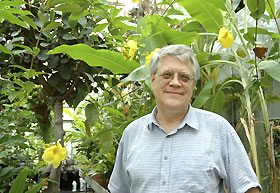For more archives, go to the Advance Archive/Search Page.
Quantitative Study Shows Extinction Threat Worse Than Predicted
The threat to the biodiversity of the natural world is in need of serious reevaluation, according to research published in the journal Science Sept. 10 by ecology and evolutionary biology professor Robert Colwell and an international team of experts.
 |
|
Robert Colwell, a professor of ecology and evolutionary biology, in coauthor
of a study on coextinction that was published recently in Science. |
The effects of human activity are already causing the decline and extinction of species around the globe, and predictions of future losses are dire. The work of Colwell and his colleagues suggests that scientists have, if anything, been underestimating the problem, by failing to properly consider the fact that the extinction of one species can precipitate the extinction of further species.
The danger of "coextinction" has long been acknowledged among biologists. It is obvious that if a species of bird becomes extinct, for example, any other organisms that are solely dependent upon that bird will disappear as well. These affiliate species might be anything from pathogens and parasitic mites, to plants with flowers adapted to bird pollination.
It would be easy to assess the risk of coextinction if there was a strict one-to-one relationship between host species and affiliates, but the situation in nature is far more complex, with host species supporting multiple affiliates (100 and counting, for one South American ant), and affiliates that can make use of multiple hosts. Until Colwell's work, nobody had attempted to sort this all out, and provide a rigorous mathematical method for looking at the phenomenon of coextinction.
The genesis of the group that tackled the problem of quantifying coextinction took place over dinner at a restaurant in Japan earlier this year. Four scientists, including Colwell and his former graduate student Robert Dunn, now at the Curtin University of Technology in Australia, decided to collaborate on a new model of the process, after attending a conference on extinction. Eventually, the collaboration grew to six researchers from six different countries on four continents.
Colwell's primary contribution was his mathematical expertise and familiarity with ecological modeling, which he used to develop a calculation of coextinction probability. Using an inverted version of what ecologists call a species accumulation curve, Colwell created a technique to "knock out hosts and see how many affiliates were left" in a computer simulation.
Colwell's silicon rainforests were firmly rooted in the real thing, by way of massive datasets on host/affiliate species relationships contributed by his co-authors. The data came from eight particularly well studied types of relationships, ranging from butterflies and the plants their caterpillars eat, to primates and their specialized fungal parasites.
The results of the group's analysis are disturbing, indicating that extinction rates for affiliate species can be expected to rise steeply after multiple host species are extirpated. What has been observed so far may be just the tip of the coextinction iceberg.
And what of the bulk of the world's species, whose affiliates are obscure? Colwell relates the story of the British Large Blue butterfly, which declined to the point of local extinction, for reasons that were mysterious until it was discovered that the butterfly was an affiliate of an ant that was also in decline. Recovery efforts for the butterfly now hinge on improving conditions for the ant, which the Large Blue tricks into caring for its caterpillars.
"If we don't know what makes butterflies in the UK tick," says Colwell, "we're in trouble when it comes to tropical arthropods."
The coextinction group also describes another model, which can be used to provide at least a rough estimate of the danger to the affiliates of poorly studied species. This predictive model is in part the brainchild of Robert Dunn, one of the two principal authors of the paper, who obtained his Ph.D. in ecology and evolutionary biology from UConn in 2003.
Based on information regarding about 8,500 endangered host species, Dunn and his colleagues calculate that worldwide, there are about 6,300 affiliates of these species that are currently "coendangered," a word Colwell coined. Most of these coendangered species are probably unknown at present —not part of one of the few well understood host/affiliate groups nor carefully enough studied to justify formal inclusion in the list of species recognized as endangered.
Just weeks after its publication, the Science paper has created new interest in the problem of coextinction, and Colwell has been busy fielding questions and comments — all positive so far — from fellow biologists as well as the media.
In addition to expanding the frontiers of ecological science, the coextinction paper has been a feather in their caps for the established researchers among its authors, like Colwell, and an auspicious start to the careers of several young scientists, including Dunn.

